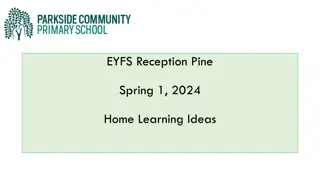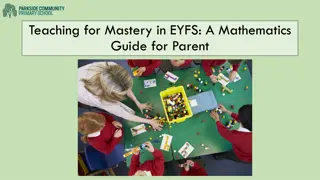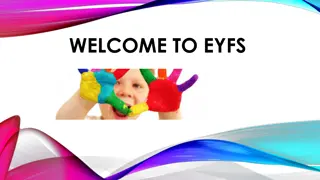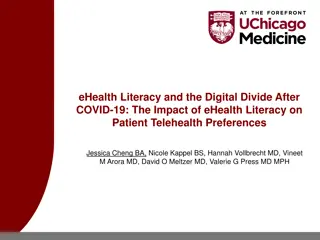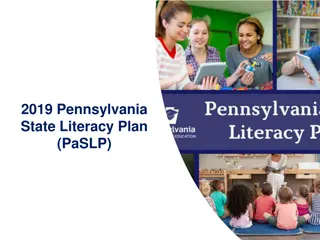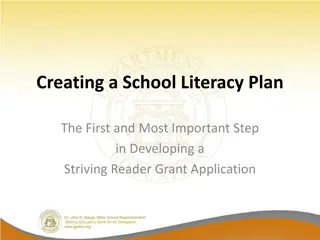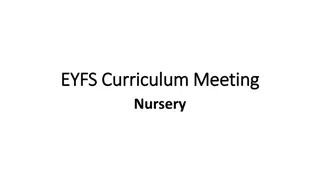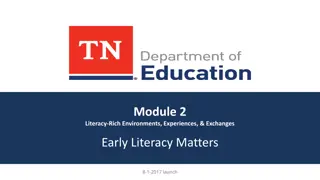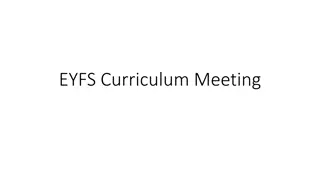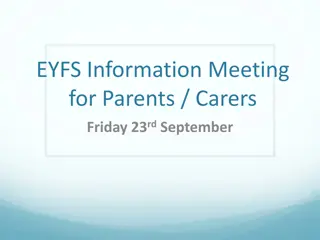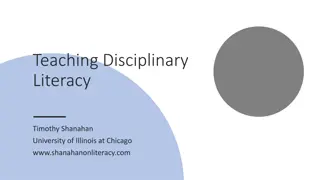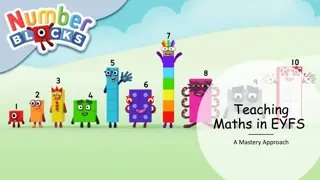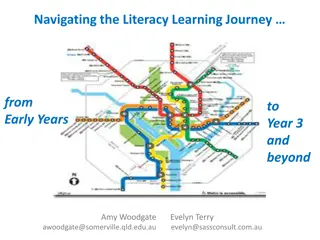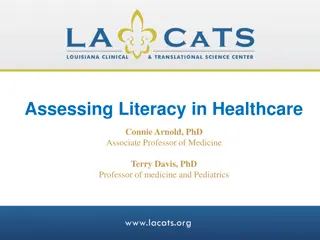Understanding the Reformed EYFS Literacy Programme
Deepen your knowledge of the reformed EYFS literacy programme with a focus on writing to support children's development. Explore changes to the statutory framework effective from September 2021 and the importance of literacy in early childhood education. Learn about transcription, comprehension, and the National Curriculum's approach to writing. Enhance your skills to design and deliver a comprehensive literacy curriculum for young learners.
Download Presentation

Please find below an Image/Link to download the presentation.
The content on the website is provided AS IS for your information and personal use only. It may not be sold, licensed, or shared on other websites without obtaining consent from the author. Download presentation by click this link. If you encounter any issues during the download, it is possible that the publisher has removed the file from their server.
E N D
Presentation Transcript
The Reformed EYFS : Build and Strengthen Your Understanding of the Literacy educational programme writing
Aims To become more familiar with reformed eyfs. To deepen your knowledge and understanding of EYFS literacy and the aspect of writing, in order to support babies and young children to develop and learn. To raise your confidence in using your own professional judgement when observing and assessing children. To deepen your knowledge and understanding of the EYFS literacy curriculum, in order to support you to design and deliver your own literacy curriculum.
The Reformed Statutory Framework
The Reformed EYFS 2021 The Reformed EYFS 2021 Changes to the EYFS statutory framework effective from September 2021, highlight the need for practitioners to develop, extend and use their professional knowledge to support children s learning and development. Literacy is the lowest achieving area of learning in the early years and is a Government focus. Government say changes to the EYFS Statutory Framework ( September 2021) will improve outcomes for all children, but particularly the language and literacy outcomes for disadvantaged children.
Reformed Statutory framework Reformed Statutory framework Literacy Educational Programme Educational Programme Literacy It is crucial for children to develop a life-long love of reading. Reading consists of two dimensions: language comprehension and word reading. Language comprehension (necessary for both reading and writing) starts from birth. It only develops when adults talk with children about the world around them and the books (stories and non-fiction) they read with them, and enjoy rhymes, poems and songs together. Skilled word reading, taught later, involves both the speedy working out of the pronunciation of unfamiliar printed words (decoding) and the speedy recognition of familiar printed words. Writing involves transcription (spelling and handwriting) and composition (articulating ideas and structuring them in speech, before writing)
Transcription and comprehension Transcription and comprehension The National Curriculum divides writing into two broad areas: transcription and comprehension. Transcription covers the technical aspects of writing: handwriting, spelling, grammar & punctuation. Composition is about sharing their ideas and thinking about the purpose for their writing. Good writing involves balancing all these different parts as well as developing fluent, legible and, eventually, speedy handwriting. Learning to write isn t an easy job and it starts in the early years.
Reformed Statutory Framework Reformed Statutory Framework ELG Writing Children at the expected level of development will: - Write recognisable letters, most of which are correctly formed; - Spell words by identifying sounds in them and representing the sounds with a letter or letters; - Write simple phrases and sentences that can be read by others. Prime Areas Practitioners must consider the individual needs, interests, and development of each child in their care, and must use this information to plan a challenging and enjoyable experience for each child in all areas of learning and development. Practitioners working with the youngest children are expected to ensure a strong foundation for children s development in the three prime areas. The specific areas of learning provide children with a broad curriculum and with opportunities to strengthen and apply the prime areas of learning. This is particularly important in developing language and extending vocabulary.
Reformed New Statutory Framework Reformed New Statutory Framework - -Communication and Language Educational and Language Educational Programme Communication Programme The development of children s spoken language underpins all seven areas of learning and development. Children s back-and-forth interactions from an early age form the foundations for language and cognitive development. The number and quality of the conversations they have with adults and peers throughout the day in a language-rich environment is crucial. By commenting on what children are interested in or doing, and echoing back what they say with new vocabulary added, practitioners will build children's language effectively. Reading frequently to children, and engaging them actively in stories, non-fiction, rhymes and poems, and then providing them with extensive opportunities to use and embed new words in a range of contexts, will give children the opportunity to thrive. Through conversation, story-telling and role play, where children share their ideas with support and modelling from their teacher, and sensitive questioning that invites them to elaborate, children become comfortable using a rich range of vocabulary and language structures.
Birth to Five matters Birth to Five matters Literacy Literacy Literacy is about understanding and being understood. Early literacy skills are rooted in children s enjoyable experiences from birth of gesturing, talking, singing, playing, reading and writing. Learning about literacy means developing the ability to interpret, create and communicate meaning through writing and reading in different media, such as picture books, logos, environmental print and digital technologies. It involves observing and joining in the diverse ways that different people and communities use literacy for different purposes. Most importantly, literacy is engaging, purposeful and creative.
Birth to Five matters Birth to Five matters Literacy Literacy Developing literacy competence and skills is a complex, challenging yet rewarding journey that requires high-quality pedagogical activities to enhance learning. Young children need to be listened to by attentive adults who recognise and value children s choices. They need enjoyable, playful opportunities of being included and involved in the literacy practices of their home, early years setting, and community environments. They need experiences of creating and sharing a range of texts in a variety of ways, with different media and materials, with adults and peers, both indoors and outdoors, as well as learning about using different signs and symbols, exploring sound and developing alphabetic and phonetic skills.
The Unique Child The Unique Child writing writing Range 1 and 2 (birth to 18months) Writing systems are complicated ways to symbolise meaning, and children need to learn many skills and develop a lot of knowledge as they begin to write. Writing skills and understanding start to develop in babies and toddlers. Firstly, children begin to understand that written texts are symbolic and carry meaning. Later they begin to produce and read written marks purposefully (See the roots of Writing in Communication and language). What is often referred to as early mark-making is the beginning of writing. It is a sensory and physical, and cognitive experience for babies and toddlers, which enables them to see the connection between their actions and the resulting marks, recognising their own agency. (See roots of mark-making and handwriting in Playing and exploring and Physical Development).
Writing Writing - - Positive relationships Positive relationships Range 1 Encourage children to use their fingers and implements to explore and trace marks on a surface, e.g. using a spoon in their food, or a finger in the sand. Make marks together with babies and toddlers using a range of appropriate materials and tools. Range 2 Encourage children to use their fingers and implements to explore and trace marks on a surface, e.g. using a spoon in their food, or a finger in the sand. Make marks together with babies and toddlers using a range of appropriate materials and tools.
Writing enabling environment Writing enabling environment Range 1 Provide a range of materials: sand, paint, early writing apps etc. for babies and toddlers to make marks with their hands and fingers, feet and bodies. Give children large sheets of paper, trays of gloop, paint, soil etc. to make marks collaboratively. Range 2 Provide a range of materials: sand, paint, early writing apps etc. for babies and toddlers to make marks with their hands and fingers, feet and bodies. Give children large sheets of paper, trays of gloop, paint, soil etc. to make marks collaboratively.
The Unique Child The Unique Child writing writing Range 3 (18-24months) As toddlers develop, they increase their understanding of how their marks are symbolic and convey meaning. Their marks may not yet resemble letters and words but nonetheless may carry meaning for the child. Begins to understand the cause and effect of their actions in mark making Knows that the marks they make are of value Enjoys the sensory experience of making marks Range 4 (2-3years) Distinguishes between the different marks they make Enjoys drawing and writing on paper, on screen and on different textures, such as in sand or playdough and through using touch-screen technology
Writing Writing - - Positive relationships Positive relationships Range 3 Encourage different mark-making movements big, small, hard, soft, quick and slow, and different shapes, circles, lines and dots. Tell children about the marks you are making and encourage them to talk to you about theirs. Value these early mark making activities by sharing them with others including parents and carers. Write down (scribe) children s words, and read them back to children. Range 4 Listen and support what children tell you about their drawings and early writing. Write down (scribe) the words that children use and display these words, for example, with photos Co-create stories orally with individual children and in small groups. Scribe the stories and display them for children to look at independently or with a parent or friend. Encourage children to make recordings of their own stories (e.g. on a digital tablet) and create opportunities for children to perform their stories to each other.
Writing enabling environment Writing enabling environment Range 3 Introduce a range of appropriate implements including large brushes, chalk and crayons, sticks and sponges for children to trace patterns and shapes. Offer children a range of different surfaces to make marks on, inside and out, e.g. chalkboards, light boxes, sand and pathways. Provide a broad range of opportunities for early writing experiences through sensory and symbolic play. Range 4 Draw attention to marks, signs and symbols in the environment and talk about what they represent. Ensure this involves recognition of English, other languages and scripts. Provide materials which reflect cultural diversity, so children see symbols and marks with which they are familiar, and learn that there are many different script systems e.g. Arabic, Chinese, Greek and Braille. Try to have a notepad to hand (e.g. A5 size) in which you can scribe children s stories and special words and share these stories and words with children. Ensure children see you writing for a purpose, e.g. a shopping list, message for parents, labels in children s play areas or reminders for ourselves.
The Unique Child The Unique Child writing writing Range 5 (3-4years) Makes up stories, play scenarios, and drawings in response to experiences, such as outings Sometimes gives meaning to their drawings and paintings Ascribes meanings to signs, symbols and words that they see in different places, including those they make themselves Includes mark making and early writing in their play Imitates adults writing by making continuous lines of shapes and symbols (early writing) from left to right Attempts to write their own name, or other names and words, using combinations of lines, circles and curves, or letter-type shapes Shows interest in letters on a keyboard, identifying the initial letter of their own name and other familiar words Begins to make letter-type shapes to represent the initial sound of their name and other familiar words
Writing Writing - - Positive relationships Positive relationships Range 5 Notice and encourage children s drawing, painting and early writing and the meanings that they give to them, such as when a child covers a whole piece of paper and says, I m writing . Celebrate and value children s early attempts at graphic representation focusing on the meaning and content rather than letter formation. Model and include children in using signs and writing to expand playful experiences such as making signs for a shop or car wash, instructions for a ball game, a list of names for a taking turns. Support children in recognising and writing their own names. Make paper and digital books with children of activities they have been doing, using photographs of them as illustrations.
Writing enabling environment Writing enabling environment Range 5 Write down things children say to support their developing understanding that what they say can be written down, and then read and understood by someone else. Encourage parents to do this as well. Set up environments of offices, dens in the garden, library, shop, home corner with greetings cards, etc., so that children engage in literacy events in which they spontaneously participate. Provide a range of accessible materials and tools for writing as part of everyday play activity, including role play, both indoors and outdoors. Write poems and short stories together with the children, writing down ideas they suggest. Scribe children s stories and re-read and enact their stories in small group activities. Involve children when you make lists or write notes and messages. Think out loud and talk through what you are doing when writing on typing on screen. Break down your flow of speech into individual words, exemplifying the correspondence between the spoken and written word. Provide activities during which children can experiment with writing, for example, leaving a message. Encourage children to use their phonic knowledge when writing, and model this in your own writing.
Being a writer talkers and listeners .
Developing early writing skills Writing is communication. It is also a way for individuals to share their identity with others. any piece of writing should be exclusive to the individual, to show that the writer has a unique voice Helen Bromley (2006). Before writing, children need experiences of: Developing the confidence and competence with oral language. Exploring and experiencing a wide variety of stories and texts. Opportunities to develop fine and gross motor skills the physical journey of writing.
Talkers and listeners Talkers and listeners Communication and Language is a prime area focus of learning and development in early years. Children s confidence in their spoken language is crucial early foundation for later literacy in the written version Confident talkers and listeners can work out the link between sounds when you say it and what it looks like when a word is written down.
The Importance of Communication and Language development Reading and writing float on a sea of talk James Britton (1983). Our understanding of how children develop both confidence and competence across the different elements of literacy continues to grow and impact our practice. However, what remains consistent is the message that we need to ensure that children's communication and language skills are secure, building a firm foundation for learning. This is emphasised within Getting it right in the Early Years Foundation Stage (Pascal et al2019): Promoting higher order literacy skills before the child has secure development in oral language will lead to problems for these children. The evidence indicates that literacy learning should be a key element in the EYFS from birth, but that it is fundamentally linked to language development and relies on the secure development of language skills and understanding.
The Unique Child CL The Unique Child CL - -Listening and attention attention Listening and Range 1(Birth 12months) Turns toward a familiar sound then locates range of sounds with accuracy Listens to, distinguishes and responds to intonations and sounds of voices Listens to familiar sounds, words, or finger plays Range 2 (12-18months) Moves whole body to sounds they enjoy, such as music or a regular beat Concentrates intently on an object or activity of own choosing for short periods
The Unique Child CL The Unique Child CL - - Speaking Speaking Range 1 Practises and gradually develops speech sounds (babbling) to communicate with adults; says sounds like baba, nono, gogo Points and looks to make requests and to share an interest Range 2 Uses sounds in play, e.g. brrrm for toy car Uses single words Uses words to communicate for a range of purposes (e.g. teddy, more, no, bye-bye) Creates personal words as they begin to develop language
The Unique Child CL The Unique Child CL- - Understanding Understanding Range 1 Turns when hears own name Starts to understand contextual clues, e.g. familiar gestures, words and sounds Range 2 Responds to simple questions when in a familiar context with a special person (e.g. Where s Mummy?, Where s your nose?) Understanding of single words in context is developing, e.g. cup, milk, daddy
Positive relationships Positive relationships CL may do to support the unique child may do to support the unique child CL - -what the adult what the adult Babies - Range 1 and 2 (Birth 18 months) Get physically close making sure the baby can see your face, using eye contact and touch to create shared moments of interaction. Be attentive, leave space and imitate baby s response for the baby to start a serve and return conversation. Use facial expressions and a lively voice with ups and downs to show babies you are interested in them. Say the baby s name to draw their attention. Encourage playfulness, laughter, turn-taking and responses, using peek-a-boo and action rhymes. Sing songs and rhymes during everyday routines. Use repeated sounds, and words and phrases so babies can begin to recognise particular sounds. Follow the baby s focus and pay joint attention to what they are interested in.
Enabling Environment Enabling Environment CL adult may do to support the unique child adult may do to support the unique child CL - -what the what the Range 1 and 2 (Birth 18months) Let babies see and hear the sequence of actions you go through as you carry out familiar routines. Provide resources and spaces that stimulate babies interests such as a shiny bell, a book or a mirror on the floor or on your lap. Find out from parents how babies make themselves understood at home. Find out about and include home languages Tune into what different children enjoy and create environments where babbling and talking feels easy and comfortable and where children can experiment freely with the sounds they can make. Provide appropriate sensory experiences as well as opportunities for movement and private conversations and sound possibly in dens and cosy corners. Find out from parents the words that children use for things which are important to them, such as bankie for their comfort blanket, remembering to extend this question to home languages.
Enabling Environment Enabling Environment CL what the adult may provide to support the unique child may provide to support the unique child CL what the adult Range 1 and 2 (Birth 18months) Share stories, songs and rhymes from all cultures and in babies home languages and other languages common in communities. Share favourite stories, songs, rhymes or music as babies are settling to sleep, or at other quiet times. Sing frequently with young babies, encouraging them to join in. Create an environment which invites responses from babies and adults, for example, touching, smiling, smelling, feeling, listening, exploring, describing and sharing. Establish a familiar pattern by spending prolonged moments of time each day interacting with the baby, or a small group of babies. Consider what it feels like to use your voice in your environment what kinds of soundscape and sensory atmosphere do children experience? Is the invitation to join in with this environment, using voices, bodies and objects to make noise, irresistible?
Being a writer - Physical Development .
Handwriting and Physical development Learning how to communicate their thoughts, ideas and feelings is a key aspect of children s early development. At first they do this orally, but gradually they also learn to do it through the written word. In order to be able to write, children need to develop the physical skills needed. Handwriting is about putting words down on paper, while writing is the thinking of the actual words. Children need to develop their hand eye coordination, build up the muscles and control in the hands, be able to coordinate their arms and shoulders. McPhillips et al (2000) noted that children who experience difficulties with reading also have difficulties with balance and motor control, so it is vital to understand the impact of physical development on children s cognitive development.
Birth to five matters document Birth to five matters document The physical skills of writing are dependent on the development of a range of gross and fine motor skills. It is important for children to develop the necessary physical skills and coordination before attempting to teach them how to form letters. Muscle development for writing is a comprehensive process that begins with movements of the whole arm and progresses toward very detailed fine motor control at the fingertips (Adolph, 2008, p.100) There are many different specific motor skills which are necessary for a child to write successfully: Developing gross motor skills Bilateral integration (using both sides of the body in a coordinated way) Fine motor control Developing dexterity Holding and manipulating a writing tool. Activities to develop these skills will be a crucial part of the journey to becoming a writer.
What is the difference between gross What is the difference between gross and fine motor control? and fine motor control? Gross motor control is the term used to describe the development of controlled movements of the whole body, or limbs (arms or legs). Of particular importance in relation to handwriting is the development of good posture and balance. Activities such as dance, football, use of small apparatus, cycling, gripping climbing frames and building with large-scale construction kits all develop gross motor control. Fine motor control is the term used to describe smaller movements, usually of the hand and fingers (or of the feet and toes for children who communicate using touch sensitive pads with their feet). Fine motor control is best developed through activities which involve small-scale movements. Until children have gained reasonable fine motor control through art, mark making and other activities, formal handwriting worksheets are not appropriate. Many early years practitioners find that boys develop fine motor control more slowly than girls.
Developing gross motor skill Developing gross motor skill Children learn to control their bodies from the centre outwards and from the top downwards. In other words, babies build up their neck muscles so they can hold up their heads, then the trunk muscles so they can sit, and finally the whole body control and balance required for walking. Controlling these larger movements is what comes first when children are very young. So, while young children may enjoy mark-making, we must be careful not to force them into writing small as they will find it easier if they have had the chance to work on controlling their whole arm movements. This will also help them to develop a better handwriting style later on. These larger movements are usually made by children quite naturally as they play outdoors, by throwing balls or using their arms to help them climb up a slide. When they run, jump, climb, twist and twirl, young children are actually building the muscles they need for good handwriting later on. To develop gross motor skills, plan physical activities including outdoors.
Building fine motor control Building fine motor control Arm and finger control follows the same pattern: at first a child will be able to manipulate the arm from the shoulder joint; gradually they understand how to control the hands; finally they learn how to make the fine finger movements needed to write your children need to develop the fine motor control required to hold and manipulate a writing tool. They need to develop strength in their wrists and hands, and also a high level of finger control. Many of the games and activities you do in early years settings will help your children develop these movements: At snack-time, build hand and finger strength by cutting up foods, grating, squeezing and using cloths to wipe up In the sand and water trays, squeezing out sponges, pouring liquids from one jug to another and washing up. Drawing on vertical surfaces helps build strength in the wrists and is also very useful for left-handed children. Squashing and squishing activities will build up lots of strength in the hands playdough, clay, pastry, gloop and so on. Toys that involve pop-together-and-pull-apart movements are great for building finger strength.
Bilateral integration Bilateral integration crossing the mid line mid line crossing the In order to be able to write, children need to be able to coordinate both sides of their bodies together with one hand holding the paper, while the other manipulates the pen. This ability to coordinate the two sides of your body, while doing different things with each side, is known as bilateral integration . It allows us to perform activities such as tying knots, or kicking a football. Children will need to learn how to cross the mid line to be able to control their movements across the centre point of the body. It is this that will let them write without changing the pen over to their other hand midway through a line. Gross Motor Activities Jumping and skipping, Riding a bike, Catching a ball, Swimming, Beating a drum, Pushing/pulling activities, Sports. Fine Motor Activities Tying shoelaces, Threading beads, Using a knife and fork, Cutting with scissors, Doing buttons, Lacing activities, Using a ruler to draw a line
Developing dexterity Developing dexterity When writing, it is important it is that you have a high level of dexterity the ability to use hands skillfully. This skill is needed for lots of other activities too, including self-care tasks such as doing up buttons and pulling on clothes. Help children develop their dexterity by: Doing up and undoing buttons and zips Threading beads Using tweezers and chopsticks Building towers Turning keys in locks Playing with peg boards Colouring in between the lines on a picture Icing biscuits
Holding a writing tool At first, children usually grasp the pencil or pen using a fist grip, then a finger grasp. The ultimate aim is for them to learn how to use a dynamic tripod grasp , where the pen or pencil is held between the thumb and the index and middle fingers, and they should be able to do this from about three or four years old. The child makes a tripod shape with the thumb and fingers, with the pencil resting on the soft bit between the thumb and forefinger. Help your children learn how to control their individual fingers by singing lots of rhymes where the fingers hide or disappear. Keep an eye on your young writers, and encourage them to hold their writing tool correctly bad habits are easy to get into but very hard to break. Early Movers helping under 5s live active and healthy lives, Jabadao
The Unique child The Unique child - -Physical development Physical development Range 2 Belly crawling moves into crawling up on hands and knees Becomes adept at changing position from crawling to sitting in order to stop, pick up, handle and investigate objects Sits unsupported on the floor, leaving hands free to manipulate objects with both hands Picks up objects in palmar grip and shakes, waves, bangs, pulls and tugs them between two hands while looking at them Enjoys finger and toe rhymes and games. Pulls to standing from crawling, holding on to furniture or person for support Walks around furniture lifting one foot and stepping sideways (cruising)
The Unique child The Unique child - -Physical development Physical development Starts walking independently on firm surfaces and later on uneven surfaces Points with first finger, sharing attention with adult. Starts to throw and release objects overarm. Enjoys the sensory experience of making marks in food, damp sand, water, mud, paste or paint Pushes, pulls, lifts and carries objects, moving them around and placing with intent Climbs inside, underneath, into corners and between objects Manipulates objects using hands singly and together, such as squeezing water out of a sponge
Positive relationships Positive relationships Physical Development Physical Development Range 2 Enable older babies to have at least three hours a day moving and being active, taken in short periods, across the day and according to the child s interest. Develop a shared approach to managing risk that enables babies to explore and develop their abilities. Ensure that clothing supports babies mobility for crawling and is not hindering or restrictive. As much as possible, allow babies to put themselves into a sitting position rather than doing this for them. Engage babies in varied active physical experiences, such as bouncing, rolling, rocking, swooping and splashing, both indoors and outdoors. Encourage babies to use resources they can grasp, squeeze, tug and throw.
Positive relationships Positive relationships Physical Development Physical Development Be aware that babies may have limited awareness of things that might be dangerous for them. Show babies different ways to make marks in dough or paint by swirling, poking or patting it. Whilst supporting babies drive to stand and walk, continue to encourage plenty of floor play and crawling. Help parents understand the value of waiting until babies are ready to take steps by themselves, rather than providing assistance to speed things along, so as to develop their own balance and control. Provide plenty of time for babies to have bare feet during floor play and crawling, so that their feet can develop well.
Enabling environment Enabling environment - -Physical Development Physical Development Range 2 Alongside the continuing role of adult bodies, the floor is the best enabling environment for babies at this stage. Limit the time older babies spend in seats, highchairs, bouncers and other containers as this prevents the critical physical development that takes place through crawling. Plan space to encourage free movement, while being kept safe by attentive adults. Maintain a familiar and nurturing environment that allows babies to feel secure, curious and adventurous, both indoors and outdoors. Provide large cushions, tunnels, slopes and low-level steps or platforms to stimulate and challenge toddlers.
Enabling environment Enabling environment - -Physical Development Physical Development Offer continuous low-level surfaces outdoors as well as indoors, so that babies can pull up to a standing position, cruise sideways and take first steps. Provide sturdy push-along carts, wheeled toys and pull-along toys indoors and out for pushing and pulling. Use music to encourage and enjoy movements. Make play resources easily and simply accessible on shelves and open containers for children to reach and fetch for themselves. Provide resources that stimulate babies to handle and manipulate things, e.g. metal and wooden objects or board books. Use gloop (cornflour and water) in small trays so that babies can enjoy putting fingers into it and lifting them out.
Early Education Early Education Learning together series Learning together series 1. Children begin their journey towards writing by making marks. Babies love to play with spilt food and drinks, touching them with little palms and fingers to create patterns before the spill can be mopped up. They re not just making a mess, they re making marks. 2. The first clear sign that children are interested in mark making comes when they use thick crayons to make big circular and straight lines. This type of mark-making is often thought of as scribble, but it is actually an important step in learning to write, because children are trying out new things to see what happens. 3. The marks children make slowly begin to have more meaning for them, and you will be able to see this by listening to what they say when they play with pens, crayons and paper. At first, mark-making is a blend of writing and drawing, as children are keen to use their new skills. But most begin to understand the difference between drawing and writing sometime after their third birthday. They may act out writing situations, especially if they have seen other people do them.
Learning together series Learning together series 4. From first words to confident writing At around four years old, children begin to write their first words and their own name is usually the first of all. 5. The next stage of writing depends on children s knowledge of reading. As children learn about reading, letter shapes and words begin to have more meaning for them. This allows them to remember what is, after all, just a collection of shapes. Reading also allows children to work out how to write the sounds of the words that they can hear in their heads - most do not really get into the swing of reading until they are six years old. When children are learning to read, they often start to write quite simple and repetitive sentences such as I like to because they are confident about how to put these down.


